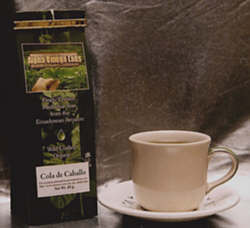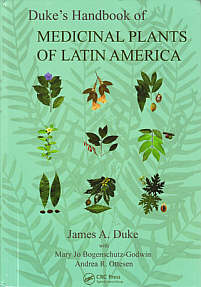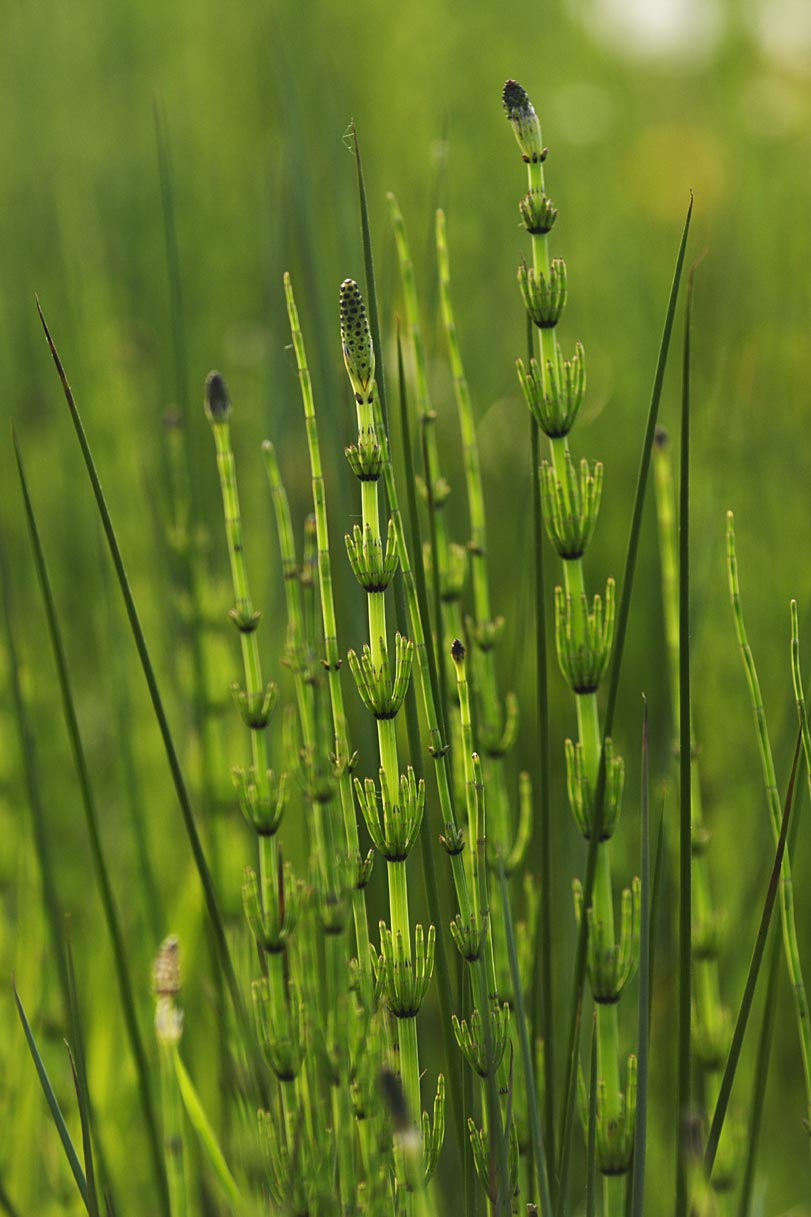
Cola de Caballo
(Equisetum bogotense Kunth. )
Ground Leaves & Stems
of Bogota Horsetail
Code 318 -- Price: $4.95
Ground tea leaves: 85 gr. (net wt)
Makes Nearly 2 Gallons of Tea
(Using 11 g. or 2 T. to make a quart)
Code 318C -- Price: $18.95
120 Capsules x 500 mg.
Order Now
 Email
Email
 Summarized Description:
Cola de Caballo Summarized Description:
Cola de Caballo is one of our native
traditionals, and although
originating from the Andes of South America, it has, over the past
century, been naturalized to many places around the world.
(If you research this plant on the internet, please don't confuse
it with the famous tourist spot of the same name in Nuevo Leon,
Mexico!)
 In addition to its traditional
medicinal uses (see below), we use this herb in our work to improve
bone repair -- a process we describe in a now-defunct product we
use to carry called Bone Builder.
 As while we're talking
about potential confusion, note that this
variety of horsetail that we sell should not be confused with
E. giganteum -- a horsetail of the same genus possessing
similar medicinal properties . . . This product can be used
as tea using the instructions below, and it also lends itself
to encapsulation by experienced end users.
Uses & Protocols
 I. Preparation --- if you can boil water, you
can make this product: Professional herbalists will
recognize this as a standard decoction. I. Preparation --- if you can boil water, you
can make this product: Professional herbalists will
recognize this as a standard decoction.
- Add 2 Tablespoons of Cola de Caballo to a large sauce pan,
along with one quart of purified water (0.95 liters).
You have enough product in the product bag to do
this seven to eight times.
- Heat until a very low-level boil or "barely boiling" level
has been reached and continue boiling for 5 minutes.
- Stir occasionally.
- Remove heat source and let cool.
- Pour the contents of your pan through a strainer
and into a large glass vase or container so
as to remove most of the tea fragments.
- Dispose of tea fragments.
- Drink your tea hot . . . refrigerate glass vase and
enjoy later as a refreshing cold tea . . . or refrigerate
and reheat later if you want to enjoy the product as a hot tea.
You may add cinnamon, lemon, and/or honey to taste.
More specific protocols for the use of the product are provided below.
 II. Protocols. II. Protocols.
 Take under the advisement
of your naturopath or other health care practitioner. Take under the advisement
of your naturopath or other health care practitioner.
Contraindications
 As a precaution, should be taken under the
advisement of a practitioner if user suffers from hypertension. As a precaution, should be taken under the
advisement of a practitioner if user suffers from hypertension.

Medicinal Activities
 Further information for practitioners:
World-famous botanist Dr. James Duke attributes the following activities
to this plant (p. 295; see hardcopy cover at right),
drawn from the extant literature. (See his graduation for "level of
efficacy" on our traditionals page;
followed by Duke's bibliographic abbreviations (in capital letters),
which we identify
on a separate page.) Further information for practitioners:
World-famous botanist Dr. James Duke attributes the following activities
to this plant (p. 295; see hardcopy cover at right),
drawn from the extant literature. (See his graduation for "level of
efficacy" on our traditionals page;
followed by Duke's bibliographic abbreviations (in capital letters),
which we identify
on a separate page.)
- Analgesic (f; MD2);
- Antiinflammatory (f; ROE);
- Antiseptic (f; MPG);
- Astringent (f; ROE);
- Cicatrizant (f; ROE);
- Depurative (f; MPG; ROE);
- Diuretic (f; EGG, JFM, MPG; X8941879);
- Emmenoagogue (f; EGG);
- Expectorant (f; DLZ);
- Hemostat (f; MPG);
- Hypertensive (f; MPG);
- Stimulant (f; EGG);
- Vasoconstrictor (f; EGG);
- Vulnerary (f; MPG).
Indications
 Further information for practitioners:
Duke provides the following indications for this plant: Further information for practitioners:
Duke provides the following indications for this plant:
- Acne (f; EGG; MD2);
- Alopecia (f; MPG);
- Bleeding (f; JFM; MPG);
- Blennorrhea (f; ROE);
- Calculus (f; DLZ; EGG);
- Cancer (f; EGG);
- Cholera (F; ROE);
- Circulosis (f; ROE);
- Colds (f; EGG);
- Colic (f; MPG);
- Cystosis (f; MPG);
- Dermatosis (f; DLZ; MD2; MPG; ROE);
- Diabetes (f; JFM);
- Dysentery (f; JFM, ROE);
- Epistaxis (f; MPG);
- Gonorrhea (f; JFM);
- Halitosis (f; DLZ);
- Hepatosis (f; DLZ; MD2);
- Infection (f; MPG);
- Inflammation (f; ROE);
- Low Blood Pressure (f; MPG);
- Lupus (f; EGG);
- Metrorrhagia (f; MPG);
- Nephrosis (f; EGG; MD2);
- Oliguria (f; JFM, MPG; X8941879);
- Ophthalmia (f; MPG);
- Pain (f; MD2);
- Pulmonosis (f; MPG);
- Pyorrhea (f; MPG);
- Sores (f; EGG; MPG);
- Splenosis (f; DLZ);
- Stomatosis (f; EGG, MPG);
- Uterosis (f; MPG);
- VD (f; JFM);
- Wounds (f; MPG; ROE).
|
 To U.S. Users: To U.S. Users: This product
have not been evaluated by the U.S. Food & Drug Administration.
It is not intended to diagnose, treat, cure, or prevent any disease.
|
 Sourcing From
Sourcing From
Amazonian Wilderness
 All the materials used to
make our Amazonian & Andean Medicinal Teas are wild-crafted and harvested
from the Central Andes and Amazonian regions of Ecuador and Peru.
There are no cultivated varieties used.
Click photo to enlarge.
Ethnobotanical
Dosage / Usage
 Duke provides a "food farmacy
potential" score for this plant of, "FNFF=X" ("I found nothing
credible suggesting the plant as food.")
 Indications for its
ethnobotanical use worldwide are broad and fall into the
following categories (p. 295):
- Cholera, cancer, renal calculi, bleeding, and as a diuretic, emmenagogue, stimulant, and for
treatment of colds, cystosis, and lupus. (Peru)
- Diuretic, emmenagogue, hemostat, litholytic, stimulant,
and vascoconstrictor -- (Bolivia).
- Colds, halitosis, phlegm, spleen function improvement -- (Bolivia).
- Sanitize sores and wounds (external); cystosis, hemorrhage (internal) -- (Costa Rica)
- Alopecia, capillary hemmorrhage, oliguria, oral ulcers, pulmonary ailments --
(Colombia)
- Kidney pains, liver ailments, correction to facial blemishes -- (Peruvians of
the Madre de Dios region)
- Collyrium, depurative, diuretic, hemostat, alopecia, metrorrhagia, ophthalmia -- (Panama)
Additional Online
Resources on
This Herb
- Bone Builder -- The combination of
Calcium Sulfate Hydronium Solution (see H3O)
with "horsetail silica" (an extract of this herb) was found by our lab to have profound
effects in speeding up the healing process of mending bones.
- Herbal Remedies as Diuretics --
Included in this review are the revelant species of Equisetum.
- An FDA "pre-market"
notification for a variety of herbs, including "cola de caballo" -- dated July, 2000.
- Michael Matus has an informative site just devoted to Equisetum --
see separate page for Equisetum bogotense.
He can be reached in person at equisetum@matus.at.
- EOL (Encyclopedia of Life) has a very respectable entry
for Equisetum bogotense,
which includes taxonomy, plant distribution, pictorial, scientific literature, and
other useful information for this species.
- Phytotherapy Research
-- Volume 8, Issue 3, p. 157-160 (May 1994). "Hypotensive and diuretic effect of Equisetum bogotense
and Fuchsia magellanica and micropropagation of E. bogotense." Typical of Wiley Online Library,
you have free access to the abstract, but it costs to obtain the article in full.
- Diuretic activity of an
Equisetum bogotense tea (Platero herb): evaluation in healthy volunteers -- source:
PubMed.gov (a consortium of the U.S. National Library of Medicine and the NIH
[National Institutes of Health]).
- Yerba de la plata --
a complete discussion of the plant in Spanish. Additional indications in Spanish provided
at InfoJardin.

Horsetail: A
Telling Morphology
 Functional foods and medicinal plants often have
a morphology -- that is, a physical form and structure that intimates what its use is.
In this case, Cola de Caballo actually LOOKS like bones connected with joints
or the phalanx bones
of the hand.
 Click image above for a closer look.
|




